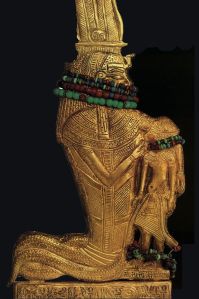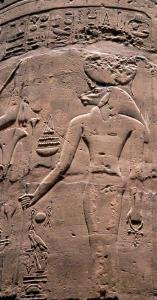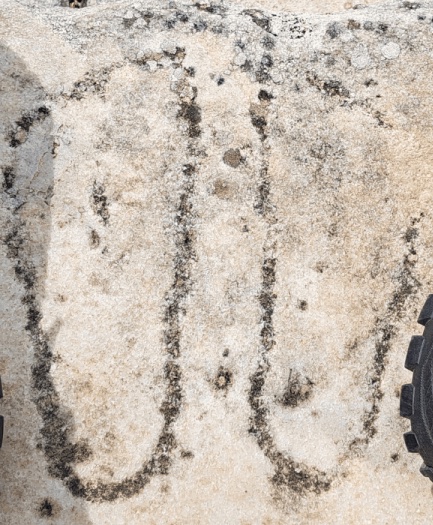Most of you reading this blog are well aware of the many epithets of Isis, Our Lady of 10,000 Names. In general, epithets are descriptions attached to the Goddess’ name that help us know more about Her. Very often, you’ll see people note that epithets are especially important in Deity invocations because they help us tune into the specific aspect of Their natures that we wish to connect with.
And that’s true.
Yet, I like to think of epithets as little Mysteries.
Each epithet of the Goddess has the possibility of revealing to us a Mystery—something about Isis we might not have known, or might not have known as deeply. In a post a couple weeks ago, one of the things we learned from the ancient Greek novel Aitheopika was that initiates of Her Mysteries called Isis the Earth and Osiris the Nile. I would not be at all surprised to learn that the revealing of additional epithets of the Goddess was a regular part of Her—and other Deities’—Mysteries. A Mystery initiation gave you insider knowledge about the Mystery Deity. Discovering new aspects of the Goddess through additional names and epithets would be some pretty solid insider information.
You’ll find epithets of Isis scattered throughout this blog. For instance, here are names and epithets honoring Isis from all over the Mediterranean world. Here are some of Her secret names from the magical papyri. There are about two hundred of Isis’ epithets listed in the appendix in Isis Magic. And Offering to Isis includes several epithets appropriate to each of the offerings—sacred symbols of the Goddess—as part of the invocation offerings.
Today, I’d like to share a few more epithets of Isis, some of which may be new to you. If you’d like to delve into the little Mysteries of these epithets for yourself, try this: Pick out a few that call to you. Open your shrine or temple in whatever manner you usually do. Invoke Isis using the epithet you chose. You can sing or chant the epithet as you call out to Her. When you sense Her presence, ask Her to reveal to you some of the Mysteries of that epithet. Then open your heart, open yourself, as you experience/intuit what She communicates to you. (Even better, jot down the things that come to your mind about that epithet for later reference. Visionary work sometimes fades rather quickly.)
In no particular order, here are some epithets of our Goddess from various parts of Egypt:
Isis, She Who Loves the Red Cloth; Iset Meret Ines—this epithet of Isis is found at Dendara. Interestingly enough, in representations of Isis, red is the most common color of Her clothing. The famous Knot of Isis is also usually made of red stone or painted red—and it may be meant to represent a knot tied in cloth. The ancient Egyptians associated red with fire, blood, and the sun. It could be a color of destructive power and associated with anger as well. We are used to Sakhmet being associated with red, but it turns out Isis is a Red Goddess, too.
Isis the Great Golden One; Iset Nebut Weret—while we are familiar with Isis being called, like Hathor, the Golden One, here She is the Great Golden One, an epithet She shares only with the Creator Goddess Neith. Gold is associated with the sun and Divinity. What does it mean that She is not only the Golden One, but the Great Golden One?
Isis, She of the Beautiful/Good/Perfect Face in the Barque of Eternity; Iset Noferet Hor em Wia Heh—the Barque of Eternity if the boat that travels into the Otherworld, both the underworld and the heavens. What does it mean that Isis is the beautiful-good-perfect face in that holy boat?
Isis the Lady of Awfulness; Iset Nebet Neru—this is the literal meaning of awful, as in “full of awe,” but also a designation of Her great, and sometimes scary, power. See more about this one here.
Isis the Great One in the Beginning; Iset Weret em Hat—this epithet is from Her temple at Philae and is another epithet Isis shares only with the Creator Goddess Neith. This is Isis as a Primeval Goddess, the First Goddess. Similarly, She is called the Great Goddess “of the coming into being” and is the Great Goddess “in the First Time,” the Zep Tepi. We also have inscriptions calling Isis Sha’et, “She Who Was First,” from a number of places, including Philae, Dendara, and Edfu.
Isis the Great in the Place of Her Heart; Iset Weret em Set Ib-Es—this one is from the Horus temple at Edfu. What do you think ‘the place of Her heart’ is?
Isis, Her Years are Eternity and Everlastingness; Iset, Renput-s Neheh Djet—learn more about Neheh and Djet here and here.
Isis the Perfect Musician; Iset Khunet Noferet—from Dendara. Isis is also called “the Musician of the Spoken Words” and the Shemayet, the “Chantress.” The Chantress was a high-ranking priestess in ancient Egypt. Read more about AE priestesses and the Chantress here.
Isis, She Who Makes Shadow with Her Feathers; Iset Iret Shut em Shuut-Es—from a stele now in the Louvre. We know about Her wing symbolism, but what about the shadow of Her wings?
Isis the Djed Pillar; Iset Djedet—now isn’t this interesting? Osiris is usually associated with the djed pillar. But here we have Isis as the female djed pillar. The djed represents stability, so that is likely the meaning here: Isis is strong, stable, dependable.
On the other hand, She also personifies Her own symbol, and is called Isis the Excellent Isis Knot (Iset Tiet Menkhet)…for Isis is All Things and All Things are Isis.
There are so many more, but that’s enough for now.
If, in your connections with Isis, you discover any of the Mysteries of these epithets, I hope you’ll share them here, on Facebook, or on BlueSky.

































































































































































































